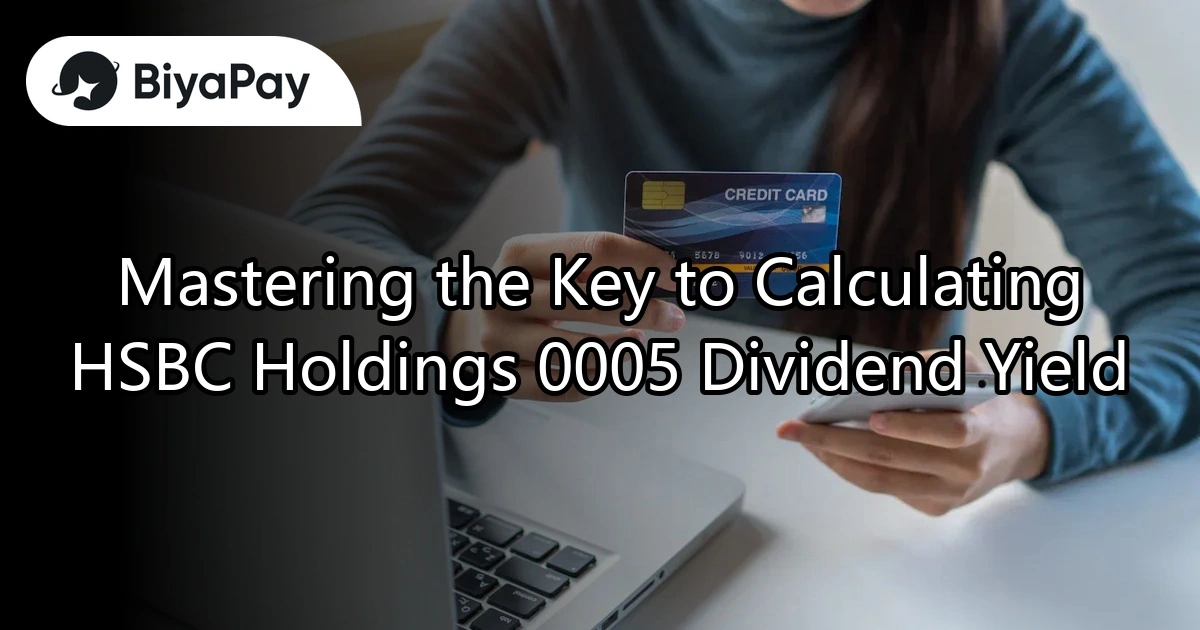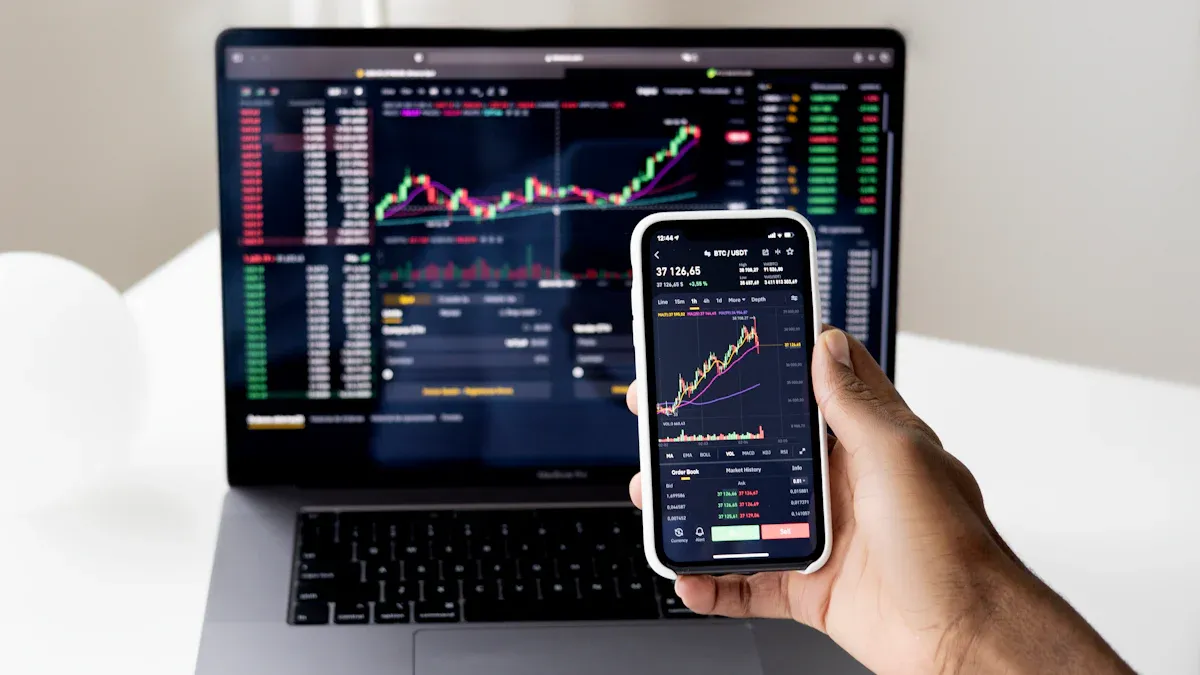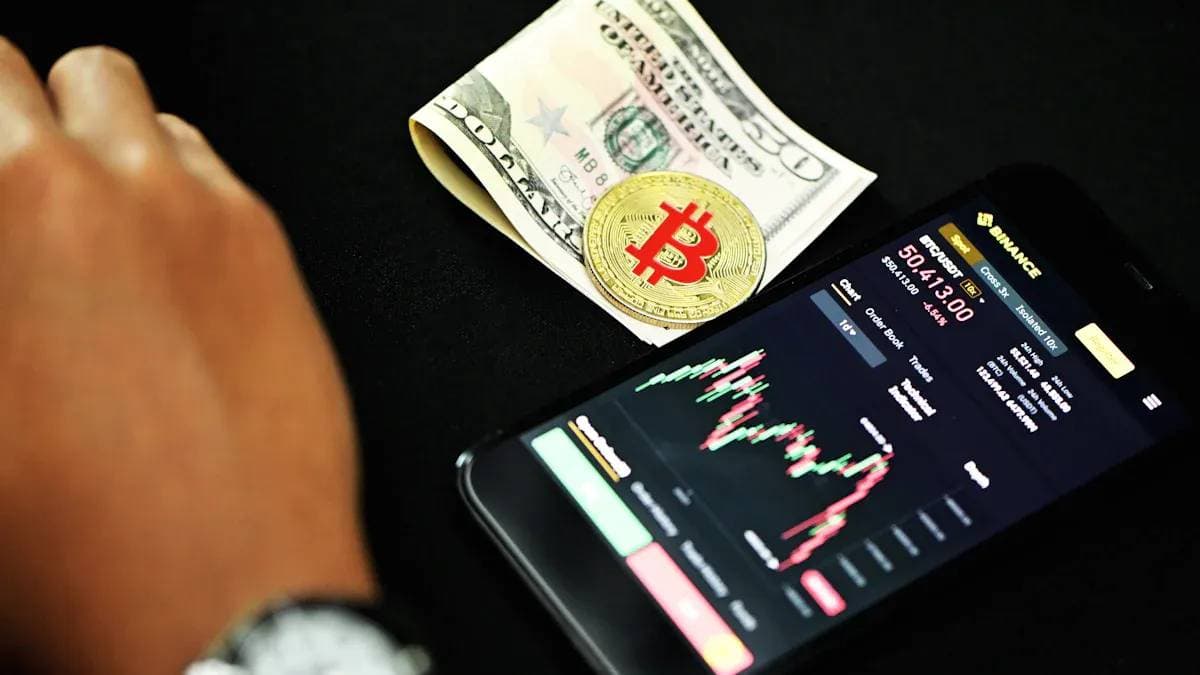- EasyCard
- Trade
- Help
- Announcement
- Academy
- SWIFT Code
- Iban Number
- Referral
- Customer Service
- Blog
- Creator
Mastering the Key to Calculating HSBC Holdings 0005 Dividend Yield

Image Source: pexels
Dividend yield is an important metric for measuring the return on stock investments. Its calculation formula is: Dividend Yield = Per-Share Dividend ÷ Current Stock Price × 100%. You need two main data points for the calculation: the per-share dividend amount and the current stock price. These data help you understand the actual return rate of the stock and evaluate whether the investment meets your expectations.
According to the latest market data, the dividend yield of equity funds is typically calculated based on the average dividend yield of the portfolio. This reflects the impact of market conditions and fund performance on returns. Changes in dividend yield may affect not only your income but also your principal. Therefore, mastering the calculation of dividend yield is crucial for developing long-term investment strategies. When analyzing dividends for stocks like HSBC Holdings (e.g., 0005 dividends), this knowledge will help you make more informed decisions.
Key Points
- Dividend yield is an important metric for evaluating the return on stock investments, calculated by dividing the per-share dividend by the current stock price and multiplying by 100%.
- HSBC Holdings has a stable dividend policy, typically paying dividends four times a year, which is crucial for investors seeking stable cash flow.
- When calculating dividend yield, you need to collect the per-share dividend amount and current stock price, and choose reliable data sources to ensure accuracy.
- Stock price fluctuations and foreign exchange rates affect dividend yield, and investors should closely monitor these factors to make informed investment decisions.
- Tracking dividend announcements and understanding dividend risks are key steps in developing long-term investment strategies, helping you better evaluate investment returns.
Basic Concepts of 0005 Dividend Yield
What is Dividend Yield?
Dividend yield refers to the cash return you receive from stock investments. When a company earns profits, it distributes a portion of those profits to shareholders in the form of cash, known as dividends. Dividend yield measures the proportion of these cash returns relative to your investment amount. To calculate dividend yield, you need to know the per-share dividend amount and the current stock price. This metric helps you understand the return potential of an investment, especially for investors seeking stable cash flow, making dividend yield an important reference point.
Characteristics of HSBC Holdings’ Dividends
HSBC Holdings’ dividend policy is characterized by stability and attractiveness. As an international bank, HSBC Holdings typically determines dividend amounts based on its profitability and market conditions. The company is known for its stable dividend record, attracting many long-term investors. HSBC Holdings’ dividend amounts are usually calculated in US dollars (USD), which is particularly convenient for international investors holding the stock. Additionally, HSBC Holdings’ dividend policy takes into account foreign exchange rate fluctuations to ensure shareholders receive stable returns.
Dividend Frequency and Historical Record
HSBC Holdings’ dividend frequency is typically four times a year, with dividends paid quarterly. This regular dividend payment schedule allows investors to better plan their cash flow needs. According to historical records, HSBC Holdings’ dividend amounts have remained stable in most years, with increases in some years. For example, in 2022, HSBC Holdings’ total annual dividend reached USD 1.10, demonstrating its robust financial condition. When analyzing 0005 dividends, understanding its dividend frequency and historical data can help you more accurately predict future returns.
How to Calculate 0005 Dividend Yield

Image Source: pexels
Collecting Necessary Data
To calculate HSBC Holdings’ dividend yield, you first need to collect two key data points: the per-share dividend amount and the current stock price. These data can be obtained from multiple sources, such as HSBC Holdings’ official website, announcements from the Hong Kong Stock Exchange, or financial news platforms. When checking the per-share dividend amount, note that this amount is typically expressed in US dollars (USD), as per HSBC Holdings’ convention. The current stock price can be obtained in real-time from stock trading platforms or financial applications.
To ensure data accuracy, you should choose reliable data sources. For example, announcements from the Hong Kong Stock Exchange typically provide the latest dividend amounts and related details. When obtaining the stock price, ensure it reflects the latest market data, as stock prices may fluctuate at any time.
Applying the Formula
Once you have collected the necessary data, you can use the following formula to calculate the dividend yield:
Dividend Yield = Per-Share Dividend ÷ Current Stock Price × 100%
This formula is very straightforward but helps you quickly understand the return potential of your investment. For example, if HSBC Holdings’ per-share dividend is USD 1.10 and the current stock price is USD 50, the dividend yield calculation is as follows:
Dividend Yield = 1.10 ÷ 50 × 100% = 2.2%
This means that for every USD 100 invested, you can receive a dividend return of USD 2.2.
Calculation Example
Let’s illustrate how to calculate the 0005 dividend yield with a practical example. Suppose you obtained the following data in October 2023:
- Per-Share Dividend Amount: USD 1.20
- Current Stock Price: USD 55
Using the formula, you can calculate as follows:
Dividend Yield = Per-Share Dividend ÷ Current Stock Price × 100%
Dividend Yield = 1.20 ÷ 55 × 100% ≈ 2.18%
This indicates that HSBC Holdings’ dividend yield is approximately 2.18%. This figure helps you assess whether the stock aligns with your investment goals. If you are seeking stable cash flow, this yield may be a good choice.
Tip: When calculating dividend yield, remember to consider the impact of exchange rates. If you purchase the stock in Hong Kong dollars (HKD), the USD dividend amount needs to be converted to HKD based on the current exchange rate to more accurately assess actual returns.
Factors Affecting 0005 Dividend Yield

Image Source: pexels
Changes in Dividend Policy
HSBC Holdings’ dividend policy directly affects your investment returns. The company may adjust dividend amounts based on profitability, economic conditions, or market demand. When the company’s profits increase, dividend amounts typically rise, which is good news for you. Conversely, if the company faces financial pressure or market instability, dividend amounts may decrease. You need to closely monitor HSBC Holdings’ financial reports and dividend announcements to understand the reasons and trends behind policy changes.
Additionally, HSBC Holdings’ dividend policy may be influenced by regulatory requirements. For example, financial regulators in some countries or regions may require banks to retain more capital to address risks, which could lead to a reduction in dividend amounts. You should regularly check HSBC Holdings’ official announcements to stay updated on the latest policy information.
Tip: When analyzing 0005 dividends, pay attention to the details of policy changes, such as the magnitude and reasons for dividend increases or decreases. This information helps you more accurately assess investment returns.
Impact of Stock Price Fluctuations
Stock price fluctuations are a significant factor affecting dividend yield. When HSBC Holdings’ stock price rises, the dividend yield may decrease because the denominator in the formula becomes larger. Conversely, when the stock price falls, the dividend yield may increase. You need to pay attention to stock price fluctuations, especially during periods of market instability.
Stock price fluctuations are typically influenced by multiple factors, including global economic conditions, industry competition, and company performance. For example, if HSBC Holdings announces strong quarterly results, the stock price may rise, potentially leading to a lower dividend yield. You should regularly track stock price trends and analyze them in conjunction with dividend amounts.
Note: Stock price fluctuations may impact your investment decisions. When the stock price is too high, the dividend yield may no longer be attractive. You need to choose the right time to buy or sell based on your investment goals.
Impact of Foreign Exchange Rates
HSBC Holdings’ dividend amounts are typically calculated in US dollars (USD), but if you invest in Hong Kong dollars (HKD), fluctuations in foreign exchange rates may affect your actual returns. When the USD to HKD exchange rate rises, your dividend amount may increase. Conversely, if the USD to HKD exchange rate falls, your dividend amount may decrease.
Foreign exchange rate fluctuations are typically influenced by international economic conditions, interest rate policies, and market sentiment. For example, interest rate adjustments by the US Federal Reserve may cause fluctuations in the USD exchange rate. You need to closely monitor exchange rate trends and adjust your investment strategy based on exchange rate changes.
Recommendation: When calculating 0005 dividend yield, remember to convert USD amounts to HKD and consider the impact of exchange rates. This helps you more accurately assess actual returns.
Practical Recommendations for Investors
How to Track Dividend Announcements
Tracking dividend announcements is a key step in understanding investment returns. You can obtain HSBC Holdings’ dividend information from multiple reliable sources, such as the Hong Kong Stock Exchange announcements, HSBC Holdings’ official website, or financial news platforms. These sources typically provide the latest dividend amounts, payment dates, and related details.
For more efficient tracking, you can subscribe to HSBC Holdings’ email notification service or use financial applications to set up reminder functions. This way, you can stay instantly updated on the latest dividend information and avoid missing important announcements. Additionally, regularly checking disclosure documents from the Hong Kong Stock Exchange can help you understand changes in the company’s dividend policy.
Tip: When tracking 0005 dividend announcements, verify whether the dividend amount is calculated in US dollars (USD) and convert it to Hong Kong dollars (HKD) based on the exchange rate for a more accurate assessment of actual returns.
Paying Attention to Dividend Risks
While dividends can provide stable cash flow, they also come with certain risks. You need to understand the market risks that may affect dividends, including the following aspects:
- Credit Risk: A deterioration in the company’s financial condition may lead to reduced dividends.
- Interest Rate Risk: Rising interest rates may increase the company’s financing costs, affecting dividend capacity.
- Liquidity Risk: Insufficient cash flow may limit dividend amounts.
- Market Volatility: Significant stock price fluctuations may affect dividend yield.
To mitigate risks, you should closely monitor HSBC Holdings’ financial reports and market dynamics and adjust your investment strategy based on the latest information.
Note: A reduction in dividend amounts may impact your investment returns. When market risks increase, it’s recommended to reassess your portfolio to ensure a balance between risk and return.
Comparing Dividend Yield with Other Returns
When evaluating investment returns, you should compare dividend yield with other forms of returns. For example, compared to capital appreciation, dividend yield is more suitable for investors seeking stable cash flow. If you are more focused on long-term appreciation, you may need to consider the potential growth of the stock price.
Additionally, compared to other investment vehicles (such as bonds or fixed deposits), stocks typically offer higher dividend yields but also come with higher risks. You need to choose the appropriate investment method based on your risk tolerance and financial goals.
Recommendation: When comparing returns, consider the impact of exchange rates, especially when dividend amounts are calculated in US dollars (USD). This helps you more accurately assess actual returns.
The process of calculating dividend yield involves three key steps: collecting data, applying the formula, and analyzing results. You need to master these steps to more accurately assess investment returns. Here are some practical statistical insights to enhance the significance of your calculations:
- Fund dividends are typically calculated based on the average dividend yield.
- Dividend timing and amounts are determined by the company and may occur quarterly, semi-annually, or annually.
- Adjustments to dividend yield need to consider factors such as dividend rates, bond yields, and exchange rate risks.
Through this knowledge, you can better analyze HSBC Holdings’ dividend yield and develop more informed investment strategies.
FAQ
1. How to Check HSBC Holdings’ Dividend Amount?
You can obtain dividend amount information from the following sources:
- HSBC Holdings’ official website
- Hong Kong Stock Exchange announcements
- Financial news platforms
Tip: Subscribing to HSBC Holdings’ email notifications allows you to stay instantly updated on the latest dividend information.
2. Why Are HSBC Holdings’ Dividend Amounts Calculated in US Dollars (USD)?
HSBC Holdings is an international bank with major operations settled in US dollars. Calculating dividend amounts in USD is convenient for international investors. If you invest in Hong Kong dollars (HKD), you need to convert the dividend amount based on the exchange rate.
3. How Do Stock Price Fluctuations Affect Dividend Yield?
Rising stock prices reduce dividend yield because the denominator in the formula becomes larger. Conversely, falling stock prices increase yield. You should closely monitor stock price trends, especially during market volatility.
4. How Do Exchange Rate Fluctuations Affect Dividend Yield?
Exchange rate fluctuations affect dividend amounts calculated in US dollars (USD). If the USD to HKD exchange rate rises, your actual returns may increase. Conversely, a falling exchange rate reduces returns.
Recommendation: Regularly monitor exchange rate trends and adjust your investment strategy based on exchange rate changes.
5. Will HSBC Holdings’ Dividend Policy Change?
HSBC Holdings’ dividend policy may change due to profitability, economic conditions, or regulatory requirements. You should regularly check the company’s financial reports and announcements to understand the reasons and trends behind policy changes.
Note: Policy changes may impact your investment returns, so stay closely informed about relevant information.
HSBC Holdings’ consistent dividend policy and 6.24% dividend yield make it an ideal choice for investors seeking stable cash flow, and a low-cost, flexible trading platform can further enhance your investment efficiency. BiyaPay offers a seamless financial solution, enabling trading in U.S. and Hong Kong stocks without offshore accounts, allowing you to participate in the market cost-effectively, whether capturing short-term HSBC price fluctuations or investing in its stable dividend-paying stocks for steady returns.
Its platform supports USD, HKD, and 30+ fiat and digital currencies with real-time exchange rate transparency, helping you navigate foreign exchange volatility and cross-border investment challenges while ensuring fund efficiency. With remittance fees as low as 0.5% across 190+ countries, it simplifies dividend fund management without high fees eroding returns. A flexible 5.48% annualized yield savings product with no lock-in period allows idle funds to grow during dividend gaps or market fluctuations, perfectly complementing your HSBC dividend investment strategy. Sign up for BiyaPay today to combine HSBC dividend data insights with BiyaPay’s low-cost, flexible tools for an efficient, stable wealth-building journey!
*This article is provided for general information purposes and does not constitute legal, tax or other professional advice from BiyaPay or its subsidiaries and its affiliates, and it is not intended as a substitute for obtaining advice from a financial advisor or any other professional.
We make no representations, warranties or warranties, express or implied, as to the accuracy, completeness or timeliness of the contents of this publication.




Contact Us
Company and Team
BiyaPay Products
Customer Services
is a broker-dealer registered with the U.S. Securities and Exchange Commission (SEC) (No.: 802-127417), member of the Financial Industry Regulatory Authority (FINRA) (CRD: 325027), member of the Securities Investor Protection Corporation (SIPC), and regulated by FINRA and SEC.
registered with the US Financial Crimes Enforcement Network (FinCEN), as a Money Services Business (MSB), registration number: 31000218637349, and regulated by FinCEN.
registered as Financial Service Provider (FSP number: FSP1007221) in New Zealand, and is a member of the Financial Dispute Resolution Scheme, a New Zealand independent dispute resolution service provider.




















